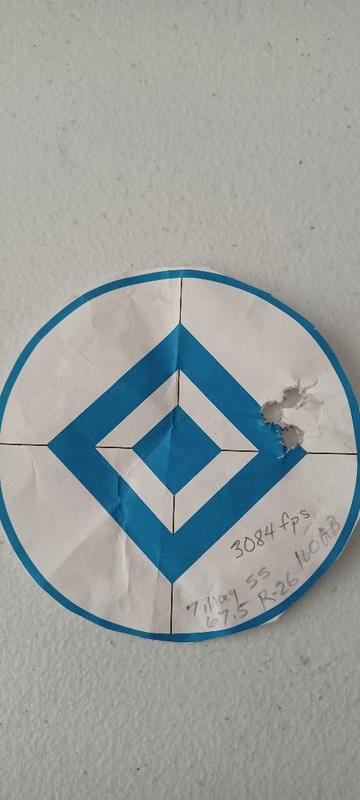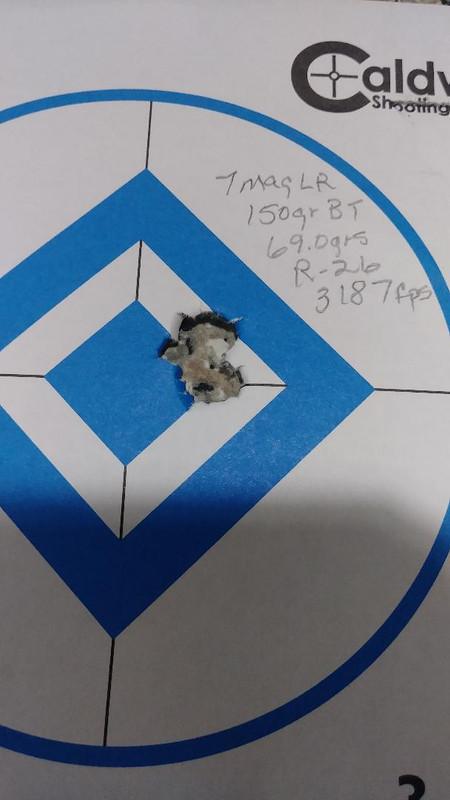Go the other way. We are jumping the heck out of my sons 7 mag with the 160AB. I mean somewhere around .100-.125 off. I'd have to check my notes.I started at about 30 thousandths off the lands now I'm at 3 and not much change in group size.
You are using an out of date browser. It may not display this or other websites correctly.
You should upgrade or use an alternative browser.
You should upgrade or use an alternative browser.
Reloader 26
- Thread starter hunter66
- Start date
 Help Support Long Range Hunting Forum
Help Support Long Range Hunting Forum
LaHunter
Well-Known Member
If you are truly targeting .003" from touching the lands, I am betting some rounds are contacting the lands and some are not, which will lead to pressure / velocity swings and poor accuracy. With Accubonds, the best CBTO precision that I can get is about +/- .002" and I am using a Redding Comp Seating Die.Trying to work up a load for my 7mm Rem Mag. using Reloader 26 as it is supposed to be non temperature sensitive, started at 65gr and am up to 67gr with no pressure signs and pumping out 3030fps but I can't get it to group, 2" group at 200yds is the best I can get. I loaded Reloader 25 in the past that shot dots but is very temperature sensitive as I missed to nice deer low at 300yds in 20 degree weather and it wasn't the guy pulling the trigger. Found out in that weather it was shooting 8" low at 300yds. I am loading .003 off the lands like I did with the RL 25. Anyone have any experience with that powder and bullet?
How are you measuring your 'jump' distance? CBTO or COAL? For me, .015" from contacting the lands (based on CBTO) has always worked well. From what I read, like in this thread, the Accubond is pretty forgiving on jump distance as long as you are not jamming/contacting the rifling.
assasinator
Member
not a lot of talk about neck sizing. it can help also.
hunter66
Well-Known Member
I will try backing it of to .015. I'm using a Hornady Comparator and Hornady O.A.L. gauge to measure where the bullet hits the lands. I subtract from that number set my bullet depth. I'm just using an RCBS seating die which may not be precise enough. Never thought about your comment that some bullets may be touching the lands. Thanks for your comments.If you are truly targeting .003" from touching the lands, I am betting some rounds are contacting the lands and some are not, which will lead to pressure / velocity swings and poor accuracy. With Accubonds, the best CBTO precision that I can get is about +/- .002" and I am using a Redding Comp Seating Die.
How are you measuring your 'jump' distance? CBTO or COAL? For me, .015" from contacting the lands (based on CBTO) has always worked well. From what I read, like in this thread, the Accubond is pretty forgiving on jump distance as long as you are not jamming/contacting the rifling.
hunter66
Well-Known Member
I backed the load .020 and added a 1/2 grain of powder and now have 2 of 3 touching at 100. I wish I had read your reply before spending a lot of time and components and got no where. Thanks again!If you are truly targeting .003" from touching the lands, I am betting some rounds are contacting the lands and some are not, which will lead to pressure / velocity swings and poor accuracy. With Accubonds, the best CBTO precision that I can get is about +/- .002" and I am using a Redding Comp Seating Die.
How are you measuring your 'jump' distance? CBTO or COAL? For me, .015" from contacting the lands (based on CBTO) has always worked well. From what I read, like in this thread, the Accubond is pretty forgiving on jump distance as long as you are not jamming/contacting the rifling.
MSURunner
Well-Known Member
I would also point out that the Hornady OAL gauge is one really tough tool to use effectively. I've left mine in the case at this point because of the inconsistencies that I would get. I find it much more accurate to create a dummy round and color the ogive with dry erase/sharpie and play with OAL length until I can get a mark from the lands. Then I back it up. There's a lot of research as well about there being a seating depth node that is not so close to the lands. Depending on cartridges, you can move those lands relatively quickly and if you're needing to be tight on the lands to get your result, you will likely work yourself out of the sweet spot in a hurry.
https://precisionrifleblog.com/2020/03/29/bullet-jump-load-development/
https://precisionrifleblog.com/2020/03/29/bullet-jump-load-development/
One thing I find helpful with the hornady tool is to stick a cleaning rod or dowel in from the muzzle. That way you work the rod and tool together and get a lot closer measurement.I would also point out that the Hornady OAL gauge is one really tough tool to use effectively. I've left mine in the case at this point because of the inconsistencies that I would get. I find it much more accurate to create a dummy round and color the ogive with dry erase/sharpie and play with OAL length until I can get a mark from the lands. Then I back it up. There's a lot of research as well about there being a seating depth node that is not so close to the lands. Depending on cartridges, you can move those lands relatively quickly and if you're needing to be tight on the lands to get your result, you will likely work yourself out of the sweet spot in a hurry.
https://precisionrifleblog.com/2020/03/29/bullet-jump-load-development/
hunter66
Well-Known Member
I backed the load .020 and added a 1/2 grain of powder and now have 2 of 3 touching at 100. I wish I had read your reply before spending a lot of time and components and got no where. Thanks again!
I will try that.One thing I find helpful with the hornady tool is to stick a cleaning rod or dowel in from the muzzle. That way you work the rod and tool together and get a lot closer measurement.
hunter66
Well-Known Member
200 yd 0Sounds more like a 100 yd zero dropping that much.
SouthLoganCountyShooter
Well-Known Member
My ca Mesa just doesn't like re26. I tried it with several bullets. 160ab and 168ablr shoot amazing with h1000 under 10k off lands.
My little Kimber 6.5CM throws Accubond LR all over the place w/RL26 - looks like a shotgun pattern. But, she'll stack Bergers or ELD on top of each other at PRC speeds using RL26. It might not be the powder.160gr AccuBond
baldhunter
Well-Known Member
I think I'm running the 160gr Accubonds around 60 thousands off the lands.Don't be afraid to jump them a little.I've hand good luck with them between 25 to a 100 thousands.Loading too close you may be getting a pressure spike.Reloader 26 was easy for me.I just added 1.5grs more than what I was loading with Reloader 22 and I had a good load.I never worked with it after that.It grouped well so I quit.I'm using Remington brass,WLRM primers.This was shot from a Remington Stainless Steel Long Range.




BrentM
Well-Known Member
160 ab I'd be at 100 off the lands. Everyone has a process and opinion but I rarely find a powder that will not shoot an accurate group at some point. Just run a traditional seating depth test at a velocity stabile charge and you'll see the result you desire.
baldhunter
Well-Known Member
I create a dummy round by loading a bullet in a sized case,then pulling the bullet and seating it twice.It loosens the neck tension enough that the second time,you seat the bullet long and chamber the round in your rifle,it will allow the bullet to seat back into the case once it touches the lands.Now you will have a dummy round that is your absolute max length to the lands.Then I use the Hornady comparator to determine how far I'm off the lands I am when seating my bullets,using the dummy round as my reference to the lands. length.I will try backing it of to .015. I'm using a Hornady Comparator and Hornady O.A.L. gauge to measure where the bullet hits the lands. I subtract from that number set my bullet depth. I'm just using an RCBS seating die which may not be precise enough. Never thought about your comment that some bullets may be touching the lands. Thanks for your comments.